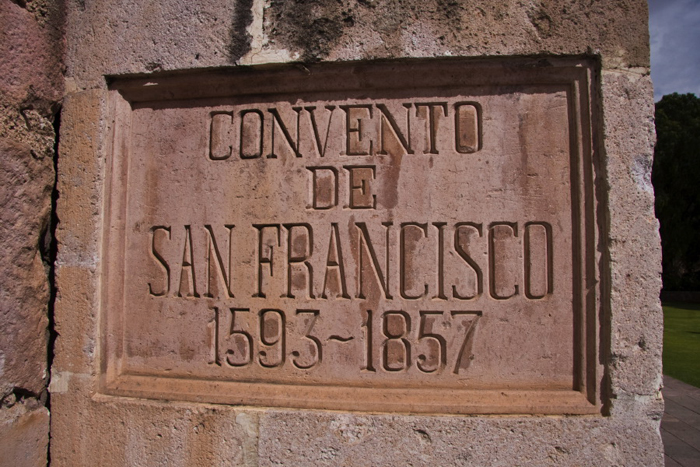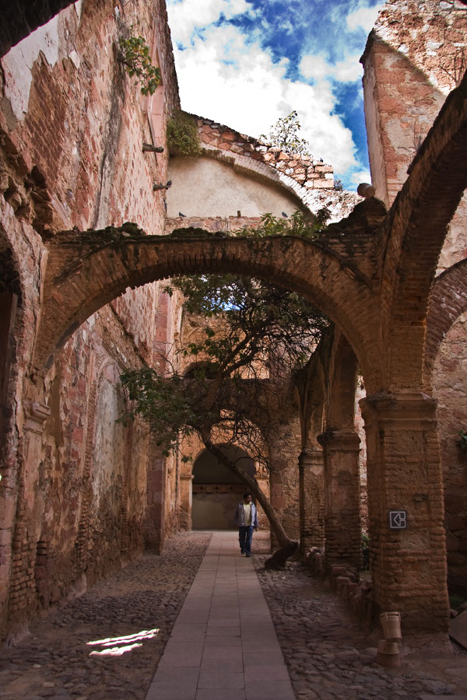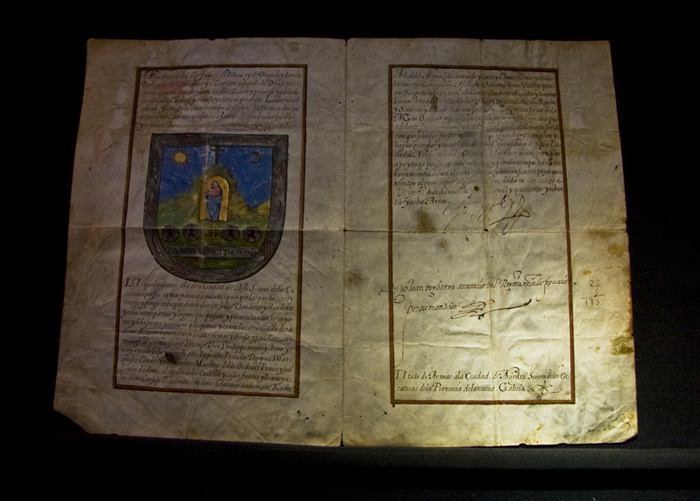
Five blocks from the Cathedral Central, left at the fork in the road with the always dry fountain, is the remains of the Convent of San Francisco. It was a convent from 1593 to 1857, and left for dust until thirty years ago. Standing outside the main entrance is a post, with an English description of the history of the building.
Below is the sign, rewritten to the letter.
“This conventual complex was one of the twelve most important ones in America. It was built in the XVI century to evangelize the indigenous peoples, and it served as a resting area for the Franciscan Friars that traveled to the north part of the country. Since 1567 Pedro de Ayala, Bishop of Nueva Galicia (Guadalajara), gave the authorization to build the property, and in the XVII and XVIII it was rebuilt various times, on one particular occasion due to a fire.
In 1924 the vault of the main nave collapsed; its rescue was started at the end of the seventies and at the beginning of the eighties of the XX century in order to host the Rafael Coronel Museum.
In the conventual complex, of great proportions, one of the most outstanding features is the beautiful baroque style façade of the church, its front wall without ochavos, the half point plaster border arches and the richly ornamented keystone.”
The arched building below is the entrance to the Ex-Convent and Museum, the ticket office is hidden in the center.

The front facade of the nave, or main church, which sits at the entrance, next to the ticket office. There is just a little slice of blue sky visible through the octogonal window above the wooden doors. The sky is visible because the roof of the church is still missing from the collapse of 1924.

The entrance sign is the only one in English, the rest are in Spanish. As my attempt to read Spanish usually ends in failure, I have found taking pictures of the signs and then translating them sentence by sentence on the internet the only way to go.
But sometimes the translations do not exactly match what I was expecting,
take this one for example:
“Este convento franciscano, fundado en el ano de 1593”
Which translated as:
“This franciscan convent, founded on the 1593 anus”
Note for today: Those little wavey lines above some letters, also known as a tilde, are important, as the word ano – with the tilde – means year, and without, means, um, something else.
Below is a view of some of the remaining arches next to the main church.

The next photograph is a large panorama of the interior of the church. Which happens to be missing its roof. The point of view is from the floor of the center of the church, where the pews used to sit.
At the bottom is the empty altar and at the top an upside down view of the wooden front doors and the same octogonal window as from the front of the church.
Note the white plaster covered walls, which are part of the restoration.
[Please click on the panorama to see its full size]

My first instinct was to translate the Spanish signs scattered about the site, and then rewritten, regurgutate them to you. But the direct translation from the internet translater are more entertaining. So the statements scattered about below, enclosed in quotations, are direct from the computer translator.
Enjoy.
“Its [the convent] influence in the advance of the western culture of that ample region was decisive.”

“The total work was promoted and executed by Mendiguta Father.”

“In 1857 the friars were forced to leave the temple and the convent.”
(it gives no reason why they were forced to leave.)

“Soon, the place was occupied by people, and convirtio in an enormous vicinity whose ceilings went away collapsing little by little, until I am uninhabitable almost in its totality.”

“The final blow happened when the enclosure was invaded by people who, boasting itself like propieterias, demolished vaults and walls to sell the stone like rubblework material.”

Below is one room of the restored convent, now a museum.

Beautiful manuscript on display, with evidence it was once used as a work sheet for someone’s math homework, 23×5=115. At least they got the correct answer.

“In the last months of 1987, goberno of the State concerto an agreement with the Secretary of Urban Development and Ecology, and some months later began restoration works, beginning with the task of retiring a layer of earth and rubbish that, in proportion of up to three meters of height, covered practically all the estate.”

A soft quiet little grove as the vines are still attempting to take over the area, with beautiful result.

On this day, the Saturday after Christmas, a bride and groom pose for photographs before the ruins and greenery. They completed their wedding vows a short time later on the front lawn, with the facade of the roofless church in the background.

Part of the unrestored convent.

“It was then when the distinguished painter zacatecano Rafael Colonel, favorite son of the State, and its son Juan Colonel Rivera, offered generously their collections of objects artisticos to the town of Zacatecas; its noble one and you disinterest gesture, did possible the creacion of this Museum.”
Inside the museum, which is the restored portion of the convent. The rooms are whitewashed, the vaulted ceilings repainted in detail, and the flat ceilings crossed with dark wooden beams. There is said to be 2500 masks on display, and it feels like it. They go on for room after room, with every variation imaginable.
Animal bones made into masks.

Mask with a large nose, I’m not entirely sure what the large protrubance is supposed to represent, I wonder if any of the women out there understand its meaning.

This alligator is the most complex and detailed example of this version of a child’s toy. The child stands in the middle, with ropes over their shoulders to hold up the toy. So the child can walk around and pretend he is an alligator. I would to complain that I never received one of these as a child, but I did get an Atari, which probably makes up for it.

This one reminds me of a Twilight Zone episode. Creepy.

Beautiful colors and a big tongue.

Proof that clowns were always creepy.

This poor little girl, standing in a alcove, missing her hands.

I have no idea what this is, or which way it is supposed to face, which is why, I guess why they put a mirror behind it. Pretty creppy too.

A large colorful mask, twice the size of a human face, with hunter pointing a gun at a large wounded cat.

And finally, more remains of the convent, with the splattered blue and white of the Mexican sky beyond.


it is beautiful.
“…until I am uninhabitable almost in its totality.â€
That’s the best translation :) I love the pictures of the doorways.
Just beautiful Ben. Would love to be there.
Was the cathedral & this convent on the Franciscan friars route from Mexico City to Sonora to California in the 1770’s? – The route that Junipera Serra took on his journeys to California?
Love
Dad
Speaking of tildes, I was informed by a Spanish speaker that the “Mono” in your current address is either “Ribbon” or “Monkey,” depending on that wily little squiggle. If your package didn’t arrive, you might need to go and talk to the people at the zoo.
What a beautiful day! I can’t believe the world can be that beautiful. Too many beautiful photos to comment on.